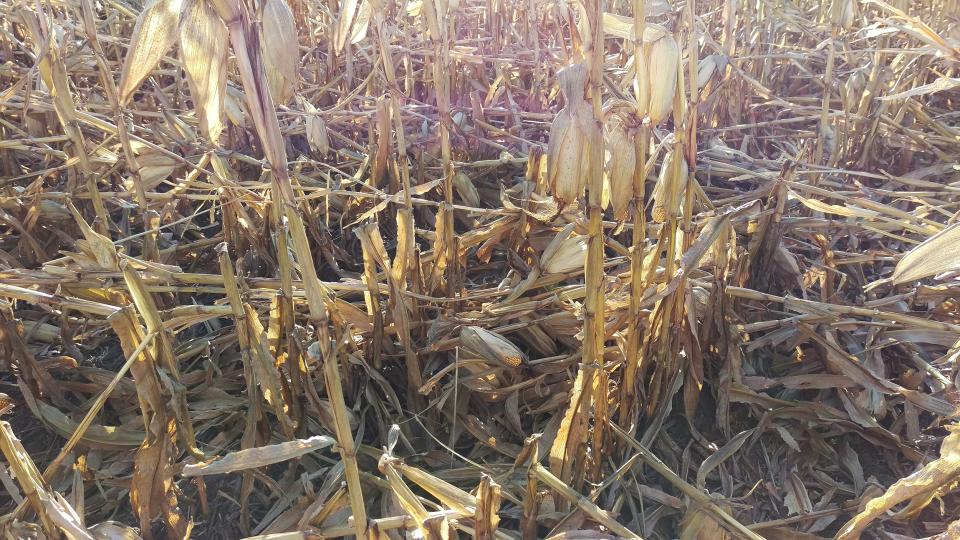
Combine Adjustments for Downed Corn
As if rain delays weren’t frustrating enough this harvest, a broad swath of southern Nebraska experienced high winds Monday, Tuesday, Thursday and Friday, downing corn and leaving 20-70 bu/ac grain on the ground in some areas, reported Jenny Rees, Extension educator in York County.
Bob Klein, Extension crops specialist in western Nebraska, advised growers to scout their fields to assess the extent of damage when deciding how best to harvest it.
"I'm seeing some fields where the stalk was snapped off above the ear. It looked bad from the road, but the grower should be able to harvest it," Klein said.
In some fields it may be beneficial to harvest the field in one direction so the snouts can get under the flattened corn, dead heading from the field end to the beginning to continue harvesting in the same direction.
Checking the fields will also help growers to priorize those areas that are weakened and most likely to go down with snow or more high winds, Klein said.
Combine Adjustments
In 2015 Nebraska faced similar challenges and Marion Calmer, farmer and president of Calmer Agronomic Research Center, Lynn Center, Illinois shared his recommendations for harvesting downed corn.
Each tip is listed below, but it’s worth the time to view the presentation where Calmer discusses each recommendation more fully and shows photos of how and where to make the combine adjustments.
Each harvest situation, manager, and combine differs. Making just two or three of these adjustments may be all that's needed, Calmer says, to improve your harvest.
- Install auto header height on your corn head.
- Flatten the corn head angle to 20°F for downed corn so gravity is less of an energy. Corn tends to slide up and over the hoods a lot easier when the head is set at a flatter angle.
- If the corn is lodged “with the row,” steepen the corn angle.
- Synchronize gathering chain speed to ground speed. (If you’re running in standing corn at 2 mph, the gathering chain should be making 27 revolutions per minute.)
- Set the clearance between the tray and cross auger flighting at 2 inches for downed corn. (Opening up the gap allows more of the dislodged material to move over the poly hood.)
- Open stripper plates
- Use more taper from bottom to top on stripper plates.
- Center the stripping tunnel above the stalk roll tunnel.
- Synchronize gathering chain lugs to be opposed from one another.
- Attach metal paddles onto every other gathering chain lug to increase the conveying capacity of the chain.
- Install a corn reel.
- Take off any end risers or tall corn extensions.
- Remove rubber ear savers.
- Add weight to poly divider snouts to help them stay under the canopy.
- Grind the wear shoe tips of the dividers or shim to give more pitch to help them stay under the canopy.
- Use stalk rolls with revolving windows,
- Start harvesting on the downwind side of the field.
- Consider turning the gathering chains around to increase aggressiveness.
Stay Safe!
Slogging through harvest with downed corn is slow, frustrating, and can fray one's nerves. Take time to rest so when you're working, you can stay alert.
Grazing Corn on the Ground
Estimating Bushels of Corn on the Ground by Counting Ears Prior to Grazing with Cattle
For more information see beef.unl.edu

Harvesting — From the Ground Up
In a 2012 CropWatch article Extension Educators shared what growers were having luck with in picking up corn:
"A survey of extension educators and specialists working with affected farmers indicated there is no simple solution to harvesting the downed corn. Some farmers are first harvesting any standing corn with a combine, then returning to the field to try to reclaim the corn on the ground through one of several routes.
"Some growers are using a V-rake to window the stalks and then coming back in with a windrow pick-up (bean) head on their combine to pick up stalks and ears from the ground. Harvest needs to be slow, as little as 1.5 mph, and the stalks and clumps of dirt will be hard on the combine and may cause it to plug. One grower had good luck tying down the rake's wheels to keep them from riding up and floating over the corn stalks. Not surprisingly, this harvest process can be hard on rake teeth.
"Other growers are using a flail chopper to finely cut the standing stalks and leaf material, then using a hay rake to gather the cut material and corn on the ground into windrows. Then they are using a combine with a windrow pick-up bean head set to run close to the ground.
"After the flail chop, other growers are baling up the plant material and corn and processing it for feed. It's recommended that the nutrient content of the feed be tested due to the above average level of corn it contains.
"Some growers also have looked into rock pickers.
"Others are going the human route and paying FFA or other youth groups to manually harvest affected fields."
Online Master of Science in Agronomy
With a focus on industry applications and research, the online program is designed with maximum flexibility for today's working professionals.
